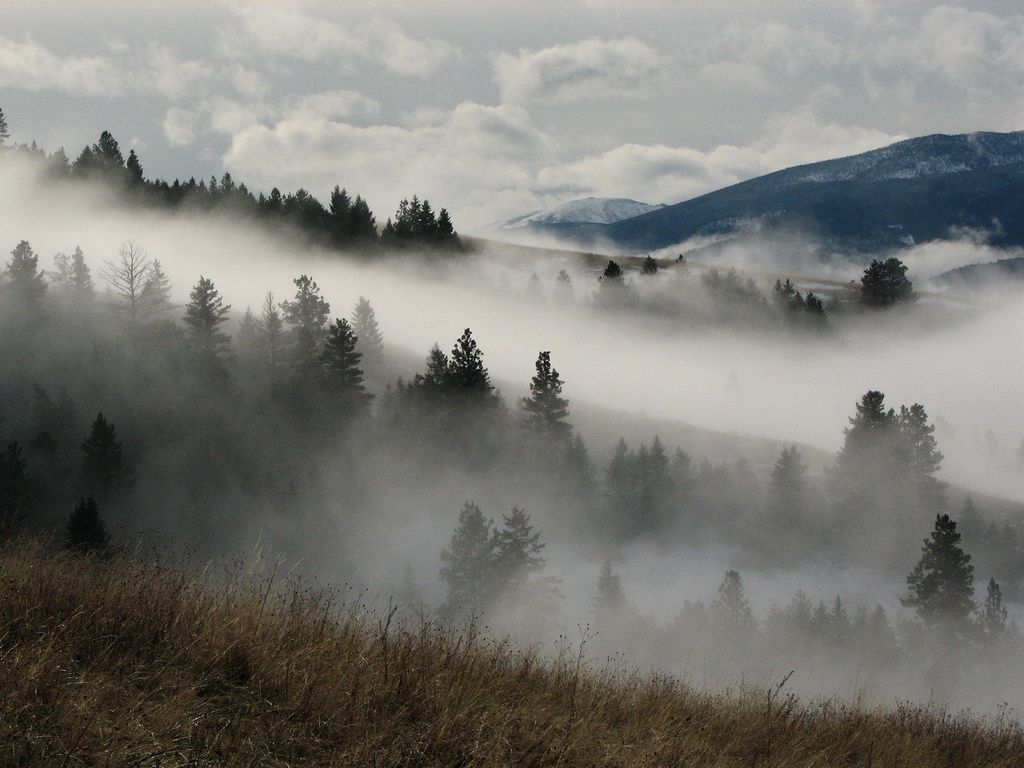The ethereal dance between valley inversions and morning mist creates one of nature’s most captivating spectacles, transforming ordinary landscapes into dreamlike visions that photographers and nature enthusiasts cherish.
🌄 The Enchanting Phenomenon of Valley Inversions
Valley inversions represent a meteorological marvel that occurs when cold air becomes trapped beneath a layer of warmer air in low-lying areas. This atmospheric reversal defies our normal expectations of temperature distribution, where we typically expect cooler conditions at higher elevations. The result is a breathtaking visual display that transforms valleys into rivers of clouds, with mountain peaks emerging like islands in a misty sea.
During clear, calm nights, the ground loses heat through radiation, cooling the air directly above it. This cold, dense air settles into valleys and basins, while warmer air remains suspended above. As dawn approaches, this temperature inversion creates the perfect conditions for fog formation, generating a spectacular blanket of mist that fills the valley floor while higher elevations bask in clear, crisp air.
The Science Behind the Beauty
Understanding the mechanics of valley inversions enhances our appreciation for this natural wonder. The process begins with radiational cooling after sunset, particularly effective during winter months when nights are longest. Clear skies allow maximum heat loss from the earth’s surface, while calm conditions prevent the mixing of air layers that would normally distribute temperatures more evenly.
The cold air drainage effect intensifies the phenomenon, as chilled air flows downslope like an invisible river, pooling in the lowest points of the terrain. This creates a distinct boundary layer where warm air sits atop cold, effectively capping the valley and preventing vertical air movement. When moisture is present in the trapped cold air, condensation occurs, producing the magnificent fog banks that define valley inversions.
☁️ Morning Mist: Nature’s Delicate Veil
Morning mist serves as the visible manifestation of valley inversions, transforming landscapes into scenes of otherworldly beauty. These suspended water droplets scatter light in mesmerizing ways, creating soft, diffused illumination that photographers dream of capturing. The interplay between mist and emerging sunlight produces a dynamic canvas that changes moment by moment.
As the sun rises, its warmth gradually disrupts the temperature inversion, causing the mist to lift, swirl, and dissipate in graceful patterns. This transitional period, often lasting only an hour or two, offers the most dramatic visual opportunities. Tendrils of fog weave between trees, cascade over ridgelines, and create mysterious silhouettes that challenge our perception of depth and distance.
The Perfect Conditions for Mist Formation
Several factors must align to create the ideal morning mist display. High relative humidity ensures sufficient moisture for condensation, while temperature differences between air layers determine the fog’s density and persistence. Wind speed plays a crucial role—too much wind disperses the mist prematurely, while complete calm allows it to linger and thicken.
- Clear skies during preceding night for maximum radiational cooling
- High humidity levels, typically above 90%
- Light to calm winds, generally below 5 mph
- Adequate moisture source from recent precipitation or nearby water bodies
- Valley geography that promotes cold air pooling
- Stable atmospheric conditions preventing premature mixing
📸 Capturing the Visual Symphony
Photographers seeking to document valley inversions face unique challenges and opportunities. The ephemeral nature of these displays demands careful planning, early rising, and often, multiple attempts before conditions align perfectly. Understanding weather patterns and terrain features becomes essential for positioning oneself at the right place and time.
The golden hour takes on enhanced significance during valley inversions, as low-angle sunlight interacts with mist to produce extraordinary color palettes. Warm oranges and pinks contrast against cool blues and grays, creating depth and atmosphere impossible to replicate in other conditions. The three-dimensional quality of light passing through fog adds texture and mood to compositions.
Technical Considerations for Mist Photography
Capturing valley inversions effectively requires specific technical approaches. Exposure settings must balance the bright sky with darker foreground elements, often necessitating graduated neutral density filters or exposure bracketing. Autofocus systems can struggle in low-contrast foggy conditions, making manual focus preferable for critical shots.
Lens selection impacts the final image significantly. Wide-angle lenses emphasize the expansive nature of fog-filled valleys, while telephoto focal lengths compress layers of mist and mountains, creating abstract compositions. Mid-range focal lengths offer versatility for capturing both intimate details and broader vistas within the same shooting session.
🏔️ Geographic Hotspots for Valley Inversions
Certain locations worldwide have earned reputations as premier destinations for observing valley inversions. These areas combine favorable topography with climate patterns that regularly produce the necessary conditions. Mountain ranges with deep valleys and basins prove most reliable, particularly in temperate zones with distinct seasons.
The Appalachian Mountains in eastern North America frequently experience inversions during autumn and winter months. European Alps provide spectacular displays, especially in Switzerland and Austria where valley settlements disappear beneath clouds while ski resorts above enjoy sunshine. The Japanese Alps offer their own unique interpretation, where cultural elements like temples and traditional villages add human interest to the natural phenomenon.
Seasonal Variations and Regional Patterns
Valley inversions occur throughout the year but show distinct seasonal patterns varying by region. Winter typically offers the most frequent and persistent inversions in temperate climates, thanks to long nights and low sun angles. Autumn runs a close second, benefiting from increased moisture following summer precipitation and cooling temperatures that promote radiational cooling.
| Season | Frequency | Duration | Visual Characteristics |
|---|---|---|---|
| Winter | High | Extended | Dense, persistent fog; dramatic lighting |
| Autumn | Moderate-High | Moderate | Colorful foliage through mist; golden tones |
| Spring | Moderate | Brief | Fresh greens; rapidly dissipating conditions |
| Summer | Low | Very Brief | Rare occurrences; quick sunrise burn-off |
🌍 Ecological Significance of Valley Fog
Beyond aesthetic appeal, valley inversions and morning mist play important ecological roles. The moisture deposited by fog provides critical hydration for plants in regions where summer rainfall proves insufficient. Coastal redwood forests in California depend heavily on fog drip, with these majestic trees harvesting water directly from mist-laden air.
Fog influences temperature regulation within valley ecosystems, moderating extremes that might otherwise stress vegetation and wildlife. The insulating effect of low-lying cloud cover protects frost-sensitive plants during cold snaps, while the cooling influence during warmer periods reduces water stress. Many specialized plant communities have evolved specifically to exploit these fog-dependent microclimates.
Wildlife and Fog Dynamics
Animals respond to valley inversions in fascinating ways. Some species exploit the reduced visibility for hunting or avoiding predators, while others adjust their activity patterns to coincide with fog presence or absence. Birds time their morning feeding to the mist dissipation, when insect activity increases with warming temperatures.
Amphibians particularly benefit from the elevated humidity associated with valley fog, allowing extended surface activity in conditions that would otherwise prove too desiccating. The acoustic properties of fog also alter how sound travels through valleys, affecting communication patterns among wildlife populations that rely on vocal signals.
🎨 Cultural and Artistic Interpretations
Valley inversions have inspired artists, poets, and writers throughout history. Traditional Chinese landscape paintings frequently depict mountains emerging from mist, symbolizing the relationship between the tangible and ethereal. Japanese aesthetics embrace the concept of yūgen, a profound awareness of beauty tinged with melancholy, perfectly embodied by morning fog in mountain valleys.
Contemporary artists continue drawing inspiration from these atmospheric phenomena. Photographers like Michael Kenna have built entire bodies of work around minimalist foggy landscapes, while painters explore the challenge of representing the intangible quality of mist on canvas. The ephemeral nature of valley inversions mirrors broader artistic themes about transience and the fleeting nature of beauty.
⚡ Climate Change and Future Patterns
Scientific research suggests climate change may alter the frequency and characteristics of valley inversions. Warming temperatures affect the delicate balance required for inversion formation, potentially reducing occurrence rates in some regions while possibly increasing them in others. Changes in precipitation patterns influence moisture availability, directly impacting mist intensity and persistence.
Long-term monitoring programs track these shifts, providing data essential for understanding broader atmospheric changes. Some mountain regions have already documented decreased fog frequency, with implications for fog-dependent ecosystems and water resources. These observations remind us that even seemingly permanent natural phenomena exist within dynamic systems subject to change.
🌟 Experiencing the Magic Firsthand
Witnessing a valley inversion demands patience, preparation, and often significant physical effort. Reaching elevated viewpoints before dawn requires early starts and careful navigation in darkness. Weather forecasting apps can help predict favorable conditions, though local knowledge and experience improve success rates dramatically.
The reward for these efforts transcends the visual spectacle alone. Standing above a fog-filled valley as sunrise transforms the scene creates profound connections with natural processes playing out on grand scales. The stillness, the gradual revelation of landscape features, and the play of light through mist combine to produce moments of genuine wonder that photographs alone cannot fully capture.
Planning Your Valley Inversion Adventure
Successful valley inversion viewing requires strategic planning. Research local geography to identify valleys with accessible high points offering commanding views. Study historical weather patterns to determine optimal seasons and conditions. Prepare for cold temperatures at elevation, even when valleys below sit under warmer inversion layers.
Safety considerations include navigating trails in darkness, potential icy conditions at higher elevations, and rapid weather changes. Inform others of your plans, carry appropriate gear including lights and warm clothing, and know your route thoroughly. The predawn hours demand extra caution, but proper preparation allows you to focus on the experience rather than concerns.
💭 The Lasting Impact of Natural Beauty
Valley inversions and morning mist remind us of nature’s capacity to transform familiar landscapes into scenes of extraordinary beauty. These atmospheric phenomena demonstrate how simple physical processes—cooling air, condensing moisture, interacting light—combine to create spectacles that inspire wonder and artistic expression across cultures and throughout history.
The visual symphony of valley inversions invites us to slow down, observe carefully, and appreciate subtle transitions often overlooked in our busy lives. Each occurrence is unique, influenced by countless variables producing unrepeatable combinations of light, mist, and landscape. This uniqueness adds value to every experience, encouraging us to remain present and fully engaged with the moment unfolding before us.
As we face environmental changes reshaping our planet, phenomena like valley inversions gain additional significance. They connect us with atmospheric processes, seasonal rhythms, and the delicate balances maintaining the natural systems we depend upon. Protecting the conditions that allow these displays to occur becomes part of broader conservation efforts ensuring future generations can also experience nature’s visual symphonies.
Whether you’re a photographer seeking the perfect shot, a nature enthusiast drawn to atmospheric beauty, or simply someone who appreciates the extraordinary within the ordinary, valley inversions offer experiences worth pursuing. The magic lies not just in the visual spectacle, but in the understanding that we’re witnessing fundamental processes that have shaped our planet’s character for millennia, creating moments of transcendent beauty available to anyone willing to seek them out. 🌄
Toni Santos is a visual storyteller and artisan whose creations celebrate the poetry of the natural world. Through his thoughtful artistic lens, Toni captures the elegance of botanical forms, transforming them into meaningful expressions of symbolism, resilience, and timeless beauty.
His journey is deeply rooted in a passion for flora and the mysteries they carry. From the shape of a petal to the curve of a vine, each design Toni brings to life reflects a deeper narrative — one of growth, transformation, and harmony with nature. Whether crafting symbolic floral jewelry, enchanted botanical illustrations, or seasonal visual studies, Toni’s work evokes the quiet magic found in Earth’s most delicate details.
With a background in handcrafted artistry and visual design, Toni blends technique with intention. His creations do more than decorate — they speak, often inspired by ancient meanings behind flowers, the cycles of the seasons, and the invisible bonds between nature and spirit.
As the creative voice behind Vizovex, Toni shares this botanical journey with the world, offering curated stories, handcrafted collections, and thoughtful articles that help others reconnect with nature’s symbolism and artistic essence.
His work is a tribute to:
The quiet power of flowers and their messages
The art of visual symbolism in everyday life
The beauty of slowing down to see what’s hidden in plain sight
Whether you’re an artist, a nature lover, or someone drawn to the deeper meanings behind the natural world, Toni welcomes you to explore a space where aesthetics meet soul — one petal, one story, one creation at a time.





